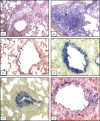Strain-specific differences in perivascular inflammation in lungs in two murine models of allergic airway inflammation
- PMID: 15996186
- PMCID: PMC1809429
- DOI: 10.1111/j.1365-2249.2005.02841.x
Strain-specific differences in perivascular inflammation in lungs in two murine models of allergic airway inflammation
Abstract
Histological data show perivascular recruitment of inflammatory cells in lung inflammation. However, the process of perivascular inflammation is yet-to-be characterized in any systematic manner at cell and molecular levels. Therefore, we investigated impact of genetic background on perivascular inflammation in acute or chronic airway inflammation in different strains of mice. Further, to address molecular mechanisms of perivascular inflammation, we examined immunohistochemical expression of vascular adhesion protein-1 (VAP-1) in chronic airway inflammation. Histological scoring revealed time and strain specific differences in perivascular recruitment of inflammatory cells in chronic and acute airway inflammation (P < 0.05). The data show that A/J strain is significantly more susceptible for perivascular inflammation followed by BALB/c and C57BL/6, while C3H/HeJ strain showed no perivascular accumulation of inflammatory cells. Of the two strains examined for perivascular inflammation in acute airway inflammation, BALB/c showed more accumulation of inflammatory cells compared to C57BL/c. VAP-1 expression occurred in the endothelium of pulmonary arteries but not in alveolar septa or airways in the control as well as challenged mice. In the inflamed lungs from A/J mice, the VAP-1 staining in pulmonary arteries was more intense compared to the other strains. VAP-1 staining was generally observed throughout the pulmonary arterial wall in chronic lung inflammation. These data show that periarterial inflammation is influenced by the genetic background, and may be partially regulated by VAP-1.
Figures




Similar articles
-
Expression of vascular adhesion protein-1 in normal and inflamed mice lungs and normal human lungs.Virchows Arch. 2003 May;442(5):491-5. doi: 10.1007/s00428-003-0802-6. Epub 2003 Apr 17. Virchows Arch. 2003. PMID: 12700900
-
Effects of an anti-inflammatory VAP-1/SSAO inhibitor, PXS-4728A, on pulmonary neutrophil migration.Respir Res. 2015 Mar 20;16(1):42. doi: 10.1186/s12931-015-0200-z. Respir Res. 2015. PMID: 25889951 Free PMC article.
-
Endothelial amine oxidase AOC3 transiently contributes to adaptive immune responses in the airways.Eur J Immunol. 2014 Nov;44(11):3232-9. doi: 10.1002/eji.201444563. Epub 2014 Sep 8. Eur J Immunol. 2014. PMID: 25116373
-
Strain-dependent activation of NF-kappaB in the airway epithelium and its role in allergic airway inflammation.Am J Physiol Lung Cell Mol Physiol. 2010 Jan;298(1):L57-66. doi: 10.1152/ajplung.00037.2009. Epub 2009 Nov 6. Am J Physiol Lung Cell Mol Physiol. 2010. PMID: 19897746 Free PMC article.
-
Role of IgE in the development of allergic airway inflammation and airway hyperresponsiveness--a murine model.Allergy. 1999 Apr;54(4):297-305. doi: 10.1034/j.1398-9995.1999.00085.x. Allergy. 1999. PMID: 10371087 Review.
Cited by
-
Inflammatory priming predisposes mice to age-related retinal degeneration.J Clin Invest. 2012 Aug;122(8):2989-3001. doi: 10.1172/JCI64427. Epub 2012 Jul 17. J Clin Invest. 2012. PMID: 22797304 Free PMC article.
-
Lesions in the lungs of fatal corona virus disease Covid-19.Ann Anat. 2021 Mar;234:151657. doi: 10.1016/j.aanat.2020.151657. Epub 2020 Dec 3. Ann Anat. 2021. PMID: 33279630 Free PMC article. Review.
-
Alpha-4 integrins and VCAM-1, but not MAdCAM-1, are essential for recruitment of mast cell progenitors to the inflamed lung.Blood. 2006 Sep 1;108(5):1588-94. doi: 10.1182/blood-2005-12-012781. Epub 2006 May 2. Blood. 2006. PMID: 16670268 Free PMC article.
-
Direct leukocyte migration across pulmonary arterioles and venules into the perivascular interstitium of murine lungs during bleomycin injury and repair.Am J Pathol. 2011 Jun;178(6):2560-72. doi: 10.1016/j.ajpath.2011.02.047. Am J Pathol. 2011. PMID: 21641381 Free PMC article.
-
Coagulation factor Xa modulates airway remodeling in a murine model of asthma.Am J Respir Crit Care Med. 2007 Jan 15;175(2):136-43. doi: 10.1164/rccm.200608-1097OC. Epub 2006 Nov 2. Am J Respir Crit Care Med. 2007. PMID: 17082493 Free PMC article.
References
-
- Mizgerd JP. Molecular mechanisms of neutrophil recruitment elicited by bacteria in the lungs. Semin Immunol. 2002;14:123–32. - PubMed
-
- Kuebler WM, Kuhnle GE, Groh J, et al. Leukocyte kinetics in pulmonary microcirculation: intravital fluorescence microscopic study. J Appl Physiol. 1994;76:65–71. - PubMed
-
- Larsen GL, Holt PG. The concept of airway inflammation. Am J Respir Crit Care Med. 2000;162:S2–S6. - PubMed
Publication types
MeSH terms
Substances
LinkOut - more resources
Full Text Sources
Research Materials

